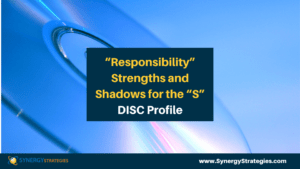Leadership is hard. It is often easier to just give in, deflect, and avoid the hard decisions that you know you should make, but that are, in fact, difficult, conflicting, or challenging. If you avoid doing the important leadership work of critical presence, tough conversations, and key decision-making, you are what I call, a squishy leader.
Squishy leadership is a pet peeve of mine. It is bothersome because it is unnecessary and easily avoided if a leader just takes the time to develop the awareness and backbone to ensure GREAT leadership. Great leadership can be developed if a leader is self-aware enough to know that they don’t have all the answers, is willing to use emotional intelligence, and is intentional about developing their own leadership skills.
A squishy leader creates ambiguity and confusion for the teams that they lead. The team can feel isolated and frustrated when trying to navigate difficult issues as a squishy leader sets them up for failure by deflecting tough decisions, refusing to remove obstacles, and failing to provide critical clarity.
Squishy leadership does not understand their role in equipping, empowering, and activating people. Instead, they give themselves permission to “think about it”, to “wait and see”, to “kick the can down the road” … almost hoping the team or the problem will solve itself. Squishy leaders do not take the bull by the horns and willingly step up and stand in the intersection of confusion, conflict, ambiguity, adversity, or change in order to assist their team with alleviating any roadblocks standing in the way of the team’s success. Squishy leadership squirms and sidesteps around the obstacles, seeming to communicate it is not their responsibility to address the issue. In contrast, great leaders get into the trenches with the team for a short time in order to understand and address issues standing in the way of the team moving forward. A leader’s support and assistance is needed because issues arise that have greater complexity or dynamics than what the team is equipped to deal with or involve information the team does not have.
A squishy leader is passive, cloaked in the robe of superficial empowerment (“I want you to think about it and find the solution”) even though the team is coming to the leader for assistance with a problem they need help finding a solution. The squishy leader often listens without creating a plan or designing next steps. Rather they allow the issue to sit, hoping it will get better with more time, even though there is no action or plan to address it.
Squishy leadership does not understand the spine, rigor, and posture needed to lead forward in the face of challenges and opposition. These moments are WHY “leaders are paid the big bucks”. This is the “tough work” that many don’t want to do. When leaders get in positions but don’t want to do this tough work, they are squishy leaders that are not really doing a leader’s job, they are leaders by title only. It is frustrating and challenging for the team because they have a leader but do not have any LEADERSHIP.
Leadership is truly a challenging skill and takes grit and guts.

A popular leadership trainer, John Maxwell, has been said to say the book he has written and is ready to go to print after he dies is Leadership Sucks. It seems like a funny book for him to write since his work is equipping and championing leaders, however, the hard truth is that the leadership job is HARD. If it doesn’t feel hard, it is worth revisiting what you might be avoiding (which would make it hard), as this might be an area where you are being squishy.
Leadership is also difficult because as a leader, you must take arrows for the team. You must take responsibility for things you didn’t do.
Many people have a hard time taking responsibility for things they didn’t INTEND or MEAN to do. They want to make excuses and be let off the hook because they TRIED and were doing their best. Really, at the end of the day, why it happened or the fact someone tried doesn’t matter. If there is a problem, leadership looks FORWARD not back. It looks for the “so what, now what”, to find the next action or adjustment needed. Leadership takes ownership of the shadows, issues, errors, and gaps that the organization and team face. Leadership stands up and in front of the challenge and then leads the way (through working with the team, research, planning, crucial conversations, co-designing, etc.) to address what is broken, not working, or failing. Leadership does not blame or make excuses, it looks to assess, strategize and then take action to advance the project, task, team, solution.
Squishy leadership is painful and often shows up as a leader’s Achilles heel. Often whatever issue they are avoiding is a shadow of their strengths (they may have other strengths but this area would be a weakness and area they are not as skilled or naturally talented). Areas of squishiness are often an indicator of a leader’s greatest weakness or fatal flaw. Because of this, the squishy parts are hard to address, and a squishy leader will struggle even harder to look at, acknowledge or even address any fatal flaw because their ego does not want them to admit they have one.
To avoid being a squishy leader:
#1) BE SELF-AWARE. be aware of your ego so you stay humble enough to see your weaknesses, which are usually directly connected to the areas that you are likely to get squishy (ie: dealing with conflict, delegating, empowering people, letting go of control, casting vision, accountability, etc.)
#2) LISTEN. Squishiness keeps happening, it comes back often and shows up again and again. Whatever you might roll your eyes at, feel exhausted by, or wonder why you are dealing with “THAT” again, is likely an area you are being squishy. It shows up again because you aren’t directly dealing with it, you are deflecting instead of addressing it. Like a boomerang, the issue is right back at your desk begging for you to pay attention to it and take action to fix it.
#3) PRACTICE POSTURE. Posture is sitting up straight or standing tall when your body is tired, and your shoulders are heavy. Posture is the muscles to stand tall when you want to shrink down and not be seen or take a break because the load is heavy. Posture is about endurance, fortitude, confidence, strength, stamina, clarity of mind, and conviction to lead forward when it is tough, the situation is foggy, and the solution is unclear.
#4) BE HUMBLE. Great leaders do not know it all and do not pretend to. They do not count on themselves to figure everything out (#ego). They know their team; they have resources (i.e., consultants, coaches, mentors, peer groups, advisors, etc.). They can admit what they don’t know and are willing to check their thinking.
#5) TAKE RESPONSIBILITY. Leaders do not shy away from tough problems and decisions, but they LEAN into them to gather information, respond, co-design, and relentlessly work to address issues and remove obstacles. It is not about over reasonability and working 24-7. Leaders understand what they can and cannot do. They understand resilience and balance. However, they do not deflect, put off and put issues in the crockpot for slow cook and marination while the team waits. Leaders address issues and work with their teams to design a plan and arrangement that supports the team while creating the space and time to solve the problem.
Squishy leadership is something we ALL can be guilty of.
It is not about if we are or are not. It is noticed that when we get squishy, we take time to understand our weaknesses or fears, address them, and engage a plan/agreement with the team.
If you are being squishy the team is affected. They are unsure if something is going to be done, are waiting for you to decide or to follow up with them, feel uncertain regarding the challenge, or feel unclear about how to proceed because they needed something from you but were supposed to continue as usual even though there is a gap.
If you are not being squishy the team feels heard, they feel understood and have heard you articulate the gap/issue, they know the action plan and feel supported.
It does not mean everything is solved. It does not mean instant answers. It does mean there is an agreed-upon plan for addressing the challenge and it is clear what the leader is doing and what the team is doing.
We all have moments of great leadership. Those do not require work because we are already naturally masterful in them. It is the areas that challenge us and our natural shadows that require work and attention and are the most likely to sabotage our great leadership.
Don’t be squishy. It is avoidable. Your work to understand and work through squishiness always pays off.






